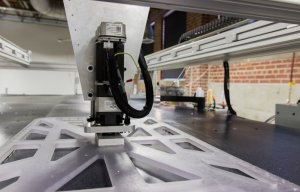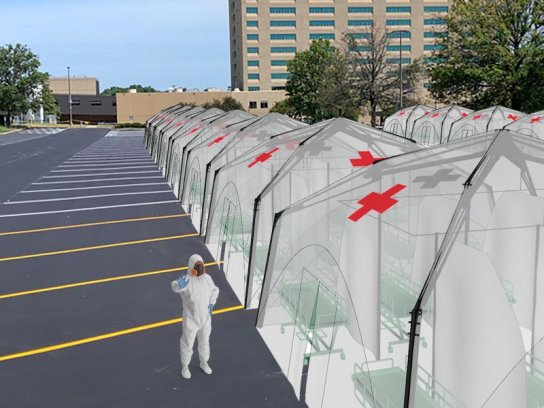
Automated Sewbot to make 800,000 adidas T-shirts daily
The robots will position the structure’s textile materials, rotate them, and pull them taut while they are being heat sealed.

10th March 2021
Innovation in Textiles
|
Brooklyn, NY
Manipulating and joining together multiple pieces of large, heavy, waterproof fabric is being allocated to robots in a project aiming to improve the manufacturing of rapidly deployed structures.
Such structures could prove vital in addressing shortages of medical care and quarantine facilities – as well as temporary housing needs – following a future pandemic or disaster.
Pvilion, a Brooklyn, New York-based manufacturer of rapidly deployable robotic structures, is working with Rensselaer Polytechnic Institute on the project to use computer automation to improve the manufacturing process. Pvilion was recently awarded a Phase II, $1.5 million Small Business Innovation Research (SBIR) contract by the US Air Force to deliver its rapidly deployable, flexible HEXT – the Hands-Off Expeditionary Tent.
Rensselaer is being funded by the US Department of Defense through the Advanced Robotics for Manufacturing (ARM) Institute. It will work on self-erecting, solar-powered structures that can be configured to suit the needs of a specific mission, including providing critical care, shelter, quarantine, infection control, or other functions.
These robots are needed to fill a real void in manufacturing that is currently present
The aim is to design, build and programme a team of small robots that will be capable of holding the structure’s textile materials, rotating them, and pulling them taut while they are being heat sealed together. The robots will work in coordination, guided by humans, as well as software and algorithms that will also be developed and built by Rensselaer researchers.
Swarm behaviour
“We’ll know the location of each robot, we’ll know which direction they are pointed, and we will know which direction they are exerting forces,” said Glenn Saunders, a senior research engineer within the Center for Automation Technologies and Systems at Rensselaer, who is leading the project with John Wen, head of the Department of Electrical, Computer, and Systems Engineering. “The swarm behaviour happens when the robots begin pulling and rotating the fabric at the sewing machine or heat sealer.”
The Rensselaer team and Pvilion will also work with Albany Medical College (AMC), which not only has expertise in health care, but also in caring for Covid-19 patients specifically. The AMC team will share its medical perspective to improve the design of the structure.
“This project answers a timely challenge in both manufacturing and health care,” Saunders said. “These robots are needed to fill a real void in manufacturing that’s currently present. They will enable faster production of a structure that could give medical teams the extra space they need to respond to a pandemic like the one we’re currently experiencing.”
“The robotic precision will permit Pvilion to increase consistency in its quality assurance processes,” said Pvilion’s Colin Touhey. “From a quality perspective, this will take our products to another level, ensuring Pvilion can ramp up its manufacturing to meet a sudden surge in demand as we have seen happen with the Covid crisis.”

Business intelligence for the fibre, textiles and apparel industries: technologies, innovations, markets, investments, trade policy, sourcing, strategy...
Find out more